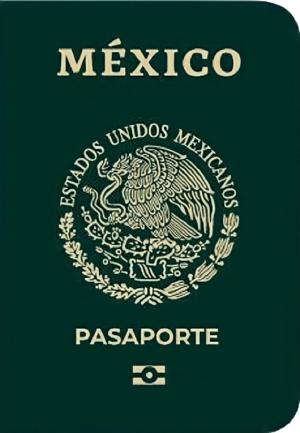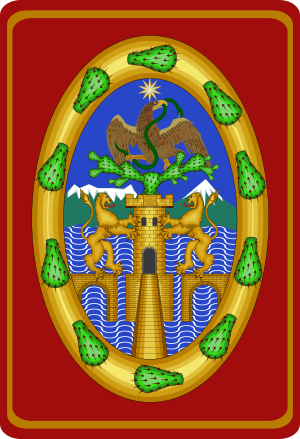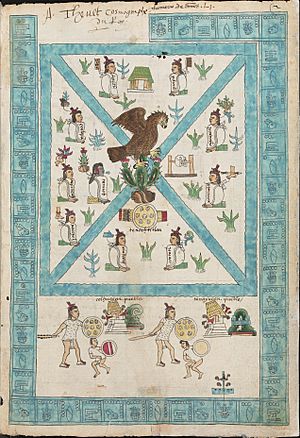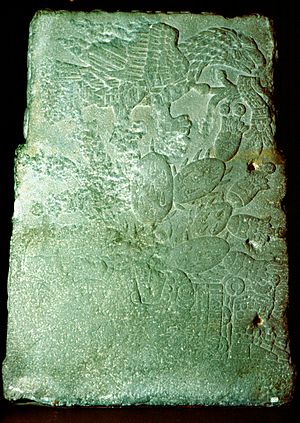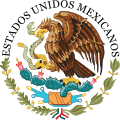Coat of arms of Mexico facts for kids
Quick facts for kids Coat of arms of MexicoEscudo Nacional de México |
|
|---|---|
 |
|
| Versions | |
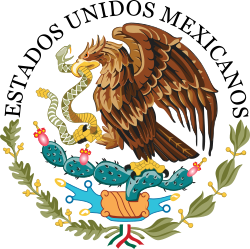
Seal of the Government of Mexico
|
|

Black and White Version of the Seal of the Government of Mexico (Linear)
|
|
| Armiger | United Mexican States |
| Adopted | 16 September 1968 (latest version, by Francisco Eppens Helguera) |
| Blazon | Atop a nopal pedestal, a Mexican golden eagle devouring a rattle snake, all proper |
| Supporters | Oak and laurel leaves, all proper |
The coat of arms of Mexico (also called the "national shield of Mexico") is a very important symbol for the country. It shows a golden eagle on a prickly pear cactus, eating a rattlesnake. This design comes from an old Aztec legend. The legend says the Aztecs would build their city where they saw this exact scene. This image has been a key symbol in Mexican politics and culture for hundreds of years. For the Aztec people, it had deep religious meaning. For Europeans, it often meant good winning over evil.
Mexican law describes the design and use of the coat of arms. It's officially called a "coat of arms," even though it's more like a "national emblem." You can see it in the middle of the flag of Mexico. It's also on Mexican peso coins and is used on official government documents. The official government seal adds the words "United Mexican States" around the top.
Contents
The Aztec Legend of Tenochtitlan
The coat of arms reminds everyone of how Mexico City was founded. Back then, it was called Tenochtitlan. The original Aztec stories about the founding of Tenochtitlan didn't always include a snake. Some old Aztec drawings, like the Codex Mendoza, only show an eagle. However, other stories say the Aztec god Huitzilopochtli told his people to look for an eagle eating a snake on a prickly pear cactus.
The symbols in the legend had different meanings long ago. The eagle stood for the sun god Huitzilopochtli. He was very important because the Aztecs called themselves "People of the Sun." The cactus was a symbol of the island where Tenochtitlan was built. For the Aztecs, the snake often represented wisdom. It was also linked to the god Quetzalcoatl.
The idea of the eagle eating a snake came from a mistake in translation. An old text said "the snake hisses," but it was wrongly translated as "the snake is torn." Because of this, a priest named Diego Durán changed the story. He said the eagle meant good things, and the snake meant evil. Even though this wasn't the original Aztec meaning, this new story became popular. It fit with European ideas of good versus evil. This helped early missionaries teach Christianity to the native people.
What the Symbols Mean
The Creatures and Plants
In 1960, a Mexican bird expert said the eagle in old Aztec drawings was likely a crested caracara. This bird is common in Mexico. However, the golden eagle is now considered Mexico's official bird. When the snake was first added to the story, it was an aquatic snake. But in 1917, it was changed to a rattlesnake. Rattlesnakes were more common in old Aztec art. Today, the snake on the coat of arms doesn't look exactly like any real snake. Its design and colors were inspired by drawings of Quetzalcoatl, who was sometimes shown as a feathered rattlesnake.
Main Parts of the Emblem
- The eagle is shown in a fighting pose.
- The snake is held by the eagle's talon (claw) and beak.
- The nopal cactus is where the eagle stands. The cactus has some of its fruits, called tunas.
- The pedestal is the base where the cactus grows. It's surrounded by the Aztec symbol for water.
- Oak and laurel leaves wrap around the eagle and cactus. They are tied with a ribbon in the colors of the Mexican flag.
Deeper Meanings
The emblem has several layers of meaning. First, it shows the name of the Aztec capital city, Tenochtitlan. The word tenoch means cactus fruit, and -tlan means "below" or "at the base of." So, it's like a picture of the city's name.
Second, it shows important Aztec beliefs about the universe. The eagle eating the serpent seems to go against some old beliefs. The eagle represents the sun and the powerful god Huitzilopochtli. The snake represents the earth. In some Aztec traditions, the snake was also linked to Coatlicue, the mother of Huitzilopochtli. In some old drawings, the eagle holds a symbol for war instead of a snake. This war symbol, called Atl tlachinolli (meaning "water and flame"), looks a bit like a snake. This might be why the snake was later added to the story.
The fruit of the nopal cactus, the tuna, represents the heart of Copil. Copil was the nephew of Huitzilopochtli. The god told his people to build their city where Copil's heart fell. This part of the legend also connects to the Aztecs' beliefs about the importance of the heart.
Other Uses of the Emblem
The seal of New Mexico (a state in the USA) also uses the eagle, snake, and cactus. A larger bald eagle protects or stands over them. This shows New Mexico's history as part of Mexico before it became part of the United States.
A Short History of the Coat of Arms
The Mexican coat of arms has changed many times over the centuries. Here are some of the most important changes:
- Ancient Times: The Aztecs used flags and symbols to organize their warriors. These symbols were like personal coats of arms.
- Colonial Era (1521-1821): During this time, Mexico was called New Spain. The main symbol was the Cross of Saint Andrew, often shown with the coat of arms of Spain.
- First Snake Appearance (1581): A priest named Father Durán drew his version of the founding of Mexico. This was the first time the snake was included with the eagle and cactus. It became a popular image, but it wasn't an official coat of arms yet.
- Independence War (early 1800s): Leaders like Father Miguel Hidalgo and José María Morelos y Pavón used different symbols. Morelos used an eagle standing on three arches with a cactus.
- First Mexican Empire (1821): When Mexico became an empire, Emperor Agustín de Iturbide added a royal crown to the eagle. The eagle was drawn in a European style, facing forward.
- First Republic (1823): After the empire, the crown was removed. New European-style elements were added to celebrate the new Republic. This design became official and was used on coins and documents.
- Second Mexican Empire (1863): Emperor Maximilian I of Mexico brought back the royal crown. The coat of arms was surrounded by an imperial robe.
- Return to Republic (1867): After Maximilian's empire fell, Mexico went back to a design similar to the 1823 version.
- Porfirio Díaz Era (1887): President Porfirio Díaz changed the eagle's look to a French style.
- Modern Design (1916-1968): President Venustiano Carranza changed the design back, bringing in more original Aztec symbols. The water snake became a rattlesnake, and the eagle was shown from the side. This design became official in 1932. In 1968, President Gustavo Díaz Ordaz made a small change to make the eagle look more powerful. This is the design still used today. A law was also created to control how national symbols are used.
- Current Law (1984): President Miguel de la Madrid Hurtado passed the current law that defines the official design and use of Mexico's national symbols, including the coat of arms.
Images for kids
See also
 In Spanish: Escudo de México para niños
In Spanish: Escudo de México para niños
- Flag of Mexico
- List of Mexican flags
- National symbols of Mexico
- Seal of New Mexico



